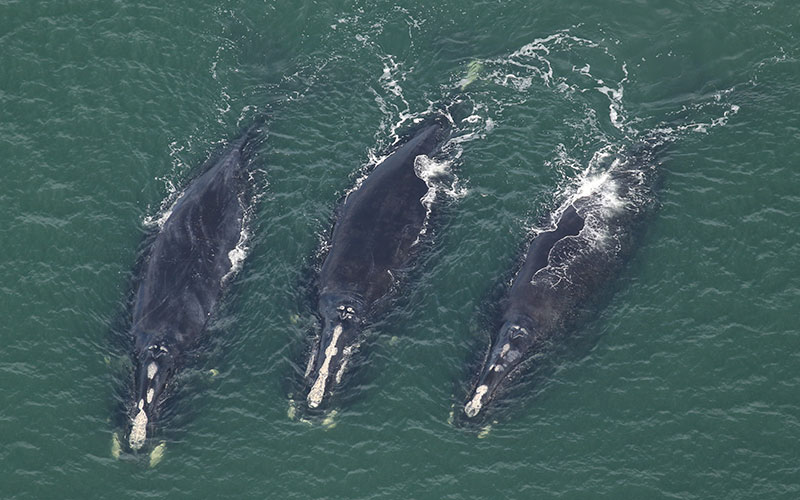
Photo credit: Clearwater Marine Aquarium Research Institute, taken under NOAA permit #20556-01
With barely 350 North Atlantic right whales remaining, it’s more urgent than ever to protect every individual. Tracking and gathering data about their movements can be a valuable tool in our arsenal. For some species of whales, monitoring can tell us how they feed, move, mother, and even “sing.”
Scientists use a variety of methods to track right whale populations, including planes, boats, underwater microphones, and, rarely, tags. Unfortunately, all of these strategies have limitations. If we want to give critically endangered right whales a chance to thrive, federal regulators must go beyond tracking. They must adopt policies that protect these majestic creatures even when we don’t know exactly where in the Atlantic they are.
Why do scientists want to monitor right whales?
In combination, current strategies to monitor right whales give people trying to protect them invaluable data that can’t be uncovered any other way. How are right whales changing their habitat use due to climate change? What migration paths are right whale mothers following when traveling up and down the busy eastern seaboard? Do pregnant whales spend more time feeding at the surface, making them more vulnerable to being struck by passing ships and boats?
Monitoring has improved scientists’ understanding of right whale behavior. But we need additional data to better understand where right whales are likely to go in the future, to anticipate their needs, and to shape policies that will allow their population to recover to a healthy level.
How do scientists track right whales?
Scientists have developed multiple methods to track right whales. Trained monitors scanning for whales from a plane or vessel is the most common way for scientists to keep an eye on them. This method of tracking is especially helpful in understanding an individual whale’s seasonal movements and habits, making these surveys particularly valuable to scientists.
“Passive acoustic monitoring” is a tool that has significantly increased our ability to detect whales. Underwater microphones can pick up right whales’ distinctive grunting “upcall.” Not all right whales vocalize, but when they do, it lets scientists know that a whale is present. Ultimately, this kind of monitoring contributes to a better understanding of right whale behavior in specific areas over time. When used on construction sites at sea, these microphones can also alert people to the presence of right whales in real time so workers can stop activities that might endanger the whales.
Under ideal circumstances, tagging whales could provide detailed information about an individual for some time, depending upon the tag, how long it stays on, and where it’s placed. However, these ideal conditions don’t yet exist (see “downsides” below). Currently, tags range from suction cup-style trackers attached via drones to dart-like trackers that burrow through a whale’s blubber and into their muscle. Some have cameras and must be retrieved to gain any information, and others transmit data to scientists via a satellite whenever a whale is on the surface.
Scientists can also learn more about right whales’ locations and movements from reports of random sightings. They also rely on futuristic strategies like examining DNA collected from marine environments or watching right whales via satellites.
What are the downsides of current tracking methods?
Unfortunately, none of these monitoring strategies provide a safe, reliable approach for tracking individual right whales over long stretches of time and distance.
Vessel and aerial surveys provide invaluable information about right whales’ activities, but they’re consistently underfunded by Congress. They’re also limited in time and scope, resulting in biased data. These surveys can’t tell us where whales go after the survey is complete.
Long term, passive acoustic monitoring can give scientists a general sense of when and where right whales are present, but even then, it misses whales that don’t vocalize, like mother and calf pairs or feeding whales. The best passive acoustic monitoring systems provide “real time” data on the presence of right whales via satellite. But this data is only reliable if it is collected continuously over hours. For example, one study focused on acoustic monitoring of offshore wind sites found that acoustic monitoring had a 74% success rate at detecting right whales when conducted for 18 hours, but just 4% when conducted for an hour.
Tagging right whales has a boatload of problems. Right whales like to roll against each other and the seafloor, typically dislodging suction cup-style tags within days. Dart-style tags typically last a few weeks at most. All tags are costly and some cause open wounds and potentially lethal infections, with the dart tags posing a particular danger. There’s new funding available for innovations in the field of satellite tagging, but safely tagging whales is still on the horizon.
Congressmen and boat manufacturers have proposed to end deadly collisions between right whales and boats by adopting an aggressive program of tagging all right whales. If we could just keep track of every whale’s location, they say, we could warn boaters when they’re approaching a whale, and they could steer clear. Proponents claim tagging would eliminate the need for seasonal speed restrictions on boats and ships when right whales are migrating along the busy eastern seaboard.
Unfortunately, the risks to whales’ health from tagging and the limitations of less invasive forms of monitoring make it impossible to safely keep tabs on whales with that level of specificity. We simply don’t have the technology to avoid collisions this way.
What else can we do?
The only reliable way to prevent lethal collisions between boats and whales is to require strict speed limits in areas where right whales are consistently present. Monitoring can help us identify those areas, even if it can’t tell us where whales are with pinpoint accuracy. Accidental collisions between vessels and whales can destroy boats, endanger humans, and kill whales – particularly calves. By requiring a 10-knot vessel speed limit for all boats capable of killing right whales in all locations where right whales are predicted to be present, both boaters and whales will be better off.
Join us in calling on Congress for policies that make the sea safer for everyone!



